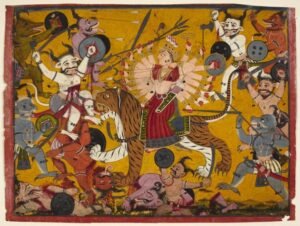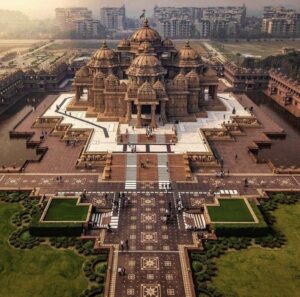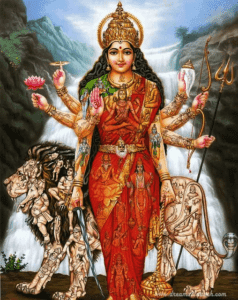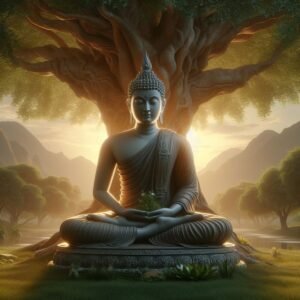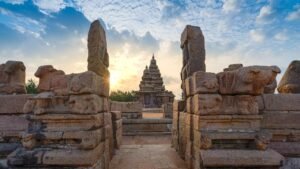Pantheon: Trimurti
Other Names: Narayana, Hari, Govinda
Who is Vishnu?
If Brahma builds the universe, Vishnu keeps it alive. As the Preserver in the Hindu Trimurti, Vishnu’s role is maintenance—not passive endurance, but active protection of cosmic order, or dharma. He is the god who intervenes when the balance of the world is threatened, restoring harmony through wisdom, strength, and compassion. While Brahma fades from worship and Shiva dances between creation and destruction, Vishnu commands devotion across India and beyond.
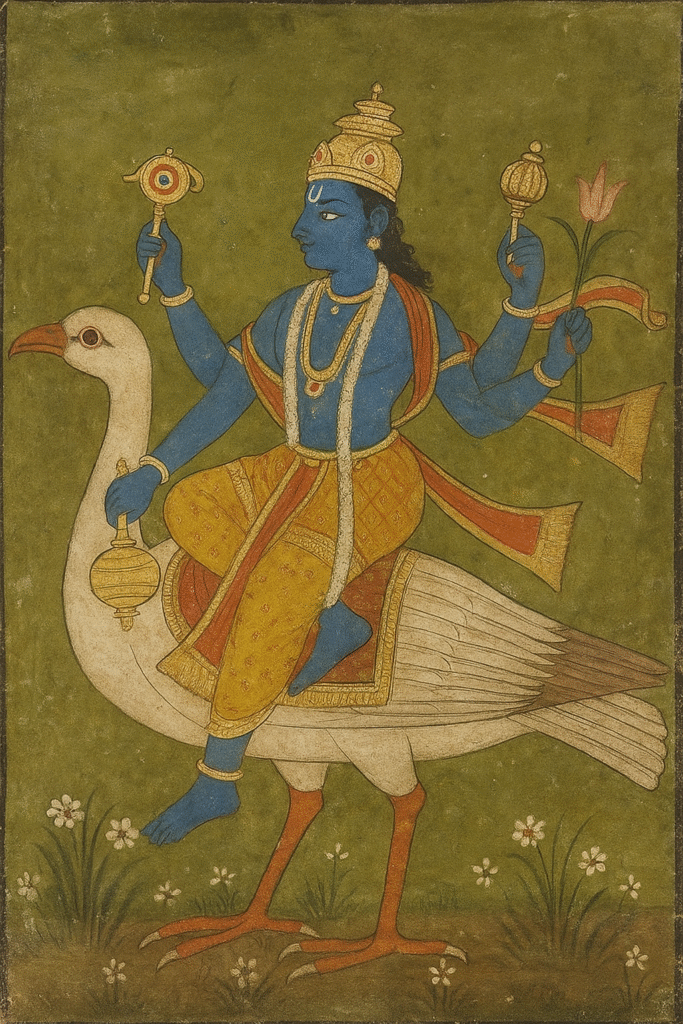
Cosmic Guardian of Dharma
Vishnu’s central function is to uphold dharma—the moral and cosmic law that keeps the universe running. He doesn’t create the universe or destroy it. He stabilizes it, keeps the gears turning, and steps in when the machinery is jammed by corruption or chaos.
This isn’t a passive job. Vishnu is a problem-solver. When evil forces rise or humanity loses its way, he descends to Earth in physical forms called avatars to set things right.
The Ten Avatars (Dashavatara)
Vishnu is most famous for his avatars, each tailored to a specific crisis in cosmic history. These include:
- Matsya (Fish) – saves the ancient scriptures and sages from a great flood.
- Kurma (Tortoise) – supports Mount Mandara during the churning of the ocean.
- Varaha (Boar) – lifts Earth from the cosmic ocean after it sinks.
- Narasimha (Man-Lion) – kills the demon Hiranyakashipu to protect a devotee.
- Vamana (Dwarf) – outwits a demon king to restore cosmic balance.
- Parashurama (Warrior-Sage) – punishes corrupt kings.
- Rama – hero of the Ramayana, ideal king and moral exemplar.
- Krishna – strategist, teacher of the Bhagavad Gita, and playful divine lover.
- Buddha – (in some traditions) preaches non-violence to curb ritual excess.
- Kalki (Future Warrior) – yet to come, he will destroy evil and reset the world.
Through these forms, Vishnu adapts to context. He’s not bound by a fixed identity—he is what the world needs, when it needs it.
Iconography and Symbols
Vishnu is usually depicted as a serene, blue-skinned figure with four arms, lying on the cosmic serpent Ananta or standing tall with a crown and jewelry, radiating authority and peace. His key symbols include:
- Conch (shankha) – the sound of creation and divine truth
- Disc (chakra) – a weapon of destruction against evil and protector of dharma
- Mace (gada) – symbol of power
- Lotus (padma) – purity and divine unfolding
His mount is Garuda, a giant eagle-like being, symbolizing speed and martial prowess. His consort is Lakshmi, goddess of wealth and prosperity, reinforcing his role as sustainer.
Theological Depth
Vishnu is not just a personal god—he’s a metaphysical principle. In the Vaishnavite tradition, Vishnu is the Supreme Being—Paramatma—and all other gods are his aspects or servants. His avatars are not just mythic figures but cosmic manifestations of divine will.
Texts like the Bhagavad Gita place Vishnu (as Krishna) at the center of Hindu theology. There, he reveals his universal form—a divine vision so vast and powerful that it terrifies even the warrior Arjuna. Vishnu is the soul of the cosmos, immanent in all beings, yet beyond all form.
Worship and Influence
Unlike Brahma, Vishnu has a massive following. The Bhakti movement across centuries was fueled largely by devotion to Vishnu and his avatars, especially Rama and Krishna. Temples, festivals, songs, and epics revolve around his stories.
From Tirupati to Vrindavan, from Ayodhya to Jagannath Puri, Vishnu’s worship is vibrant and living. The Vaishnava sect sees him not just as preserver but as the eternal god, source of all being.
Vishnu in Modern Thought
Vishnu’s adaptability makes him a powerful figure even today. He’s not just a savior; he’s a model of intervention—stepping in with clarity and purpose when things fall apart. His avatars reflect an evolving understanding of heroism: from raw strength (Parashurama) to moral leadership (Rama) to strategic intellect (Krishna).
In a chaotic world, Vishnu stands as a symbol of order with compassion—a divine force that doesn’t just maintain the world, but makes it better when it falters.
Vishnu is the keeper of the cosmic rhythm. Where Brahma sets the stage and Shiva resets it, Vishnu ensures the story plays out the way it’s supposed to. He is not detached from the world—he is deeply invested in it, returning again and again to protect, to teach, and to inspire.

